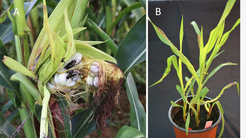Molecular phytopathology
Many years ago I have fallen in love with a fungus that infects maize and causes smut disease. This fungus, Ustilago maydis, causes large tumors in infected plants, not very appealing to the eye (Figure A) but within a week also induced in small maize seedlings under glasshouse conditions (Figure B). We use this microbe-plant interaction system to understand how fungi manage to infect plants. To establish itself in the plant tissue, U. maydis secretes a battery of mostly completely novel effector proteins. These effectors are used to suppress plant immune responses and reprogram the metabolism of the host to benefit fungal needs. Our goal is to determine where these effectors end up after being secreted, what their molecular function is, how they have evolved in the arms-race between pathogen and host and how their expression is regulated.

Our more recent achievements are:
- We determined the molecular function of the repetitive Rsp3 effector.
- We have determined the structure of the secreted chorismate mutase effector Cmu1 in collaboration with the group of G. Bange and S. Rensing and identified a maize kiwellin as interactor of Cmu1.
- By RNAseq profiling of U. maydis during all stages of the infection we have found that the effectors are expressed in discrete waves in the course of an infection.
- We have identified effector genes which have signatures of positive selection and have investigated their contribution to virulence.
- We have successfully adapted the CRISPR-Cas9 system for multiplexing to be able to target gene families in U. maydis.
- We have shown that the Tin2 effector of U. maydis has been neofunctionalized.











